
The Evolution of the Use of the Internet: the Italian Case
The author's views are entirely their own (excluding the unlikely event of hypnosis) and may not always reflect the views of Moz.
When I talk to my American SEO friends, I cannot help but notice their surprise when I tell them that Google in Italy owns 95% of the search market share. Because of this ownership, search engine optimization is virtually synonymous with Google Search Optimization in my home country.
However, Italy is not an exception.
If we examine the percentages that Statcounter.com presents of the search engines’ market shares in Europe between January 2012 to January 2013, the monopolistic percentage repeats itself again and again, with very few exceptions:
| Spain | 96.08% | Portugal | 97.31% |
| France | 93,78% | Belgium | 98.21% |
| Ireland | 94.55% | United Kingdom | 91.54% |
| Netherlands | 94.33% | Germany | 94.81% |
| Austria | 96.3% | Switzerland | 95.76% |
| Denmark | 96.48% | Norway | 91.97% |
| Sweden | 96.25% | Finland | 97.14% |
| Estonia, Lithuania, Latvia | 96.85% | Poland | 97.31% |
| Czech Republic |
77.04% |
Slovakia | 97.98% |
| Slovenia | 94.72% | Croatia | 98.19% |
| Serbia | 97.54% | Montenegro | 95.26% |
| Macedonia | 95.26% | Greece | 96.77% |
| Romania | 97.59% | Bulgaria | 97.71% |
| Turkey | 97.97% | Belarus |
71.29% |
| Ukraine |
82.74% |
Russian Federation |
57.01% |
| Malta | 92.46% | Cypre | 94.47% |
The only countries where Google does not own the majority of search results are the Czech Republic (thanks to Seznam), Belarus, Ukraine, and Russia (thanks to Yandex, which is unfortunately losing market share).
Sad, isn't it? With such a monopoly put in place by Google, it's pretty easy to understand why even a simple change in its algorithm is able to send a big portion of European SEOs into a state of panic.
But really, aren't the above figures representative of the way people actually search and find information on the Internet, and, eventually, visit our websites? The answer is yes, but not quite.
To explain my slightly contradictory answer, let's look at an interesting study a friend of mine, Paolo Zanzottera, shared at the ConvegnoGT conference in December.
Research and methodology
Paolo presented the results of an extensive analysis of data obtained through the Italian Web Analytics platform, ShinyStat. He used this data to paint a picture of what search and Internet usage in Italy has looked like over the last few years. The data samples Paolo worked with include:
- Reference period: January 1, 2010 - October 31, 2012
- Basic metric analyzed: visits (DAA) from the world of Italian sites (89.18% from Italy)
- Sampling of visits: random visits (1 random visit out of 30 in distributed days and hours of the week)
- Size of search sample: 300,117,541 visits from search engines
- Size of social sample: 47,032,022 visits from social networks
- Total size of the sample: 750,022,334 visits
- Number of sites analyzed: 3.000 websites during the fixed period of time distributed in 47 categories and divided into 5 kinds of traffic
Let's take a look at the data displayed in a more meaningful way.
Visits from search engines
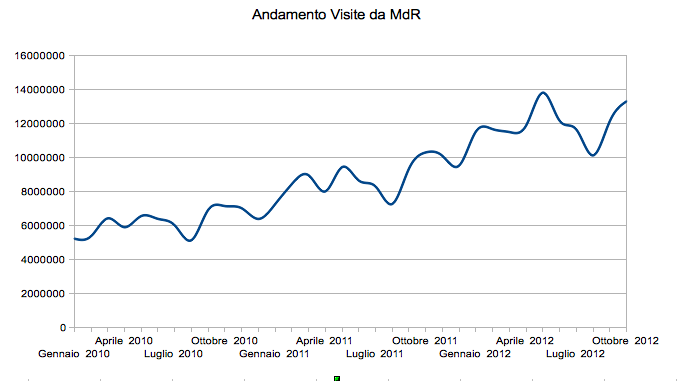
Visits from search engines to Italian sites 2010-2012
As we can see from the chart above, organic search is constantly increasing. The increase between January 2010 and October 2012 alone was 154.49 (39.34% between 2011 and 2012).
Please note that the increase is not represented as a constantly ascending line; instead, it presents a series of ups and downs, which are not justifiable only with seasonality. Indeed, the peaks of traffic volume should be explained through a bigger identification of the search engines through mass media as they are in correspondence with events that mark the news and impact on the awareness of the users (e.g. elections, political scandals, the earthquake in Emilia Romagna, sporting events, etc.).
In Italy, Google is not the only current search engine. In fact, there are international search engines like Bing, Yahoo, and Ask; and "national" search engines, such as Virgilio, Arianna, and Tiscali. Yet, as the chart below shows, the domination of Google is obvious.
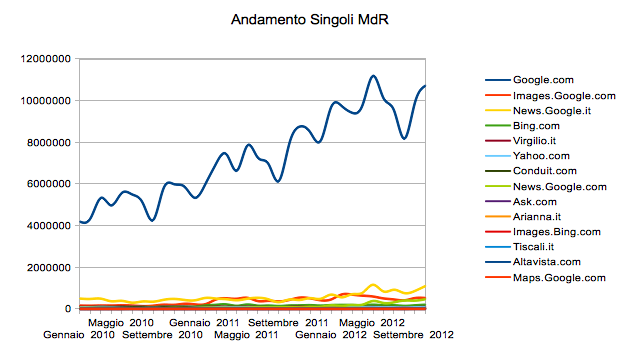
Visits from single search engines
In reality, all the Italian national search engines (and Conduit, which is French) are powered by Google, so its domination is even more evident here:
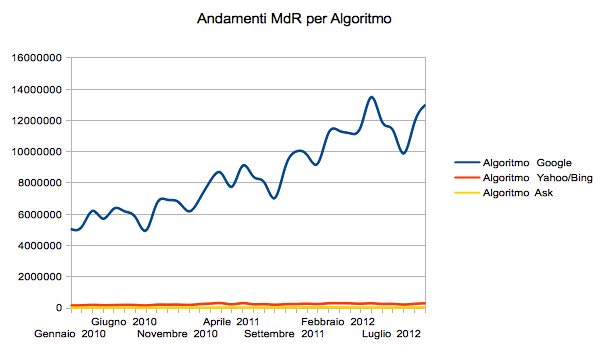
Organic visit by "algorithm"
This domination is shown even further in the following market shares. Please note that Google was able to increase their market share, despite the recent Bing/Yahoo alliance.
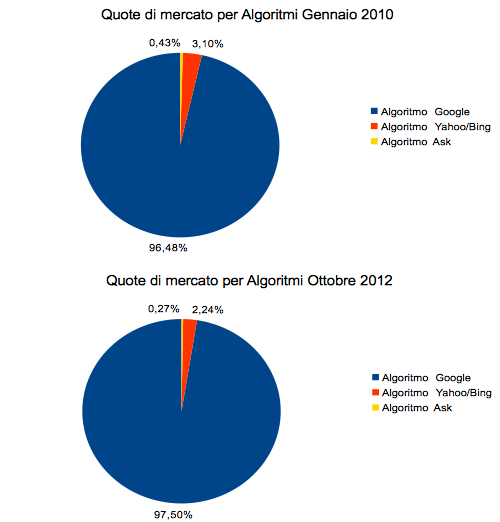
Algorithm market shares in Italy 2010 vs 2012
If Google is typically the only search engine used, then it is important to know how the organic traffic to our sites is coming from the different Google organic algorithms. In this case, the research defined four verticals:
- Web
- Images
- News
- Maps
Note: a Google vertical like YouTube is not included in this research, as it was meant as a social platform.
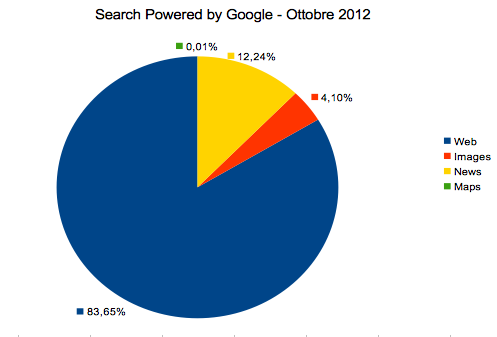
Organic search powered by Google in 2012
What about the evolution of how Italian sites where searched? The data collected by Paolo clearly show us how users are progressively moving from the old classic "one-word query" to more sophisticated middle and long-tail keywords.
It's important to note that the use of single-word queries is not typically due to a user's potential ignorance in the use of search engines, but is more likely due to searches for brand names or domain names.
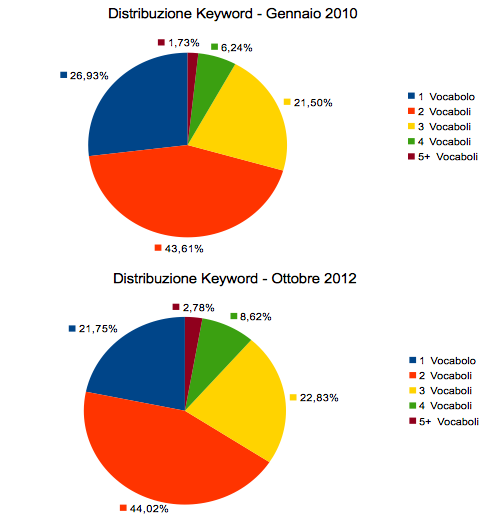
Keyword length evolution 2010 vs 2012
Another important topic when it comes to organic search is the impact of Not Provided. The chart below shows us that Not Provided is clearly impacting Italian organic search, but the percentage in October 2012 is not high enough to prevent correct SEO work ( it was at 14.85%). Nonetheless, the rise of Not Provided in organic search is impressive and constant.
Obviously, in very specific topics, the percentage of Not Provided can rise up to almost the 50% of the searches:
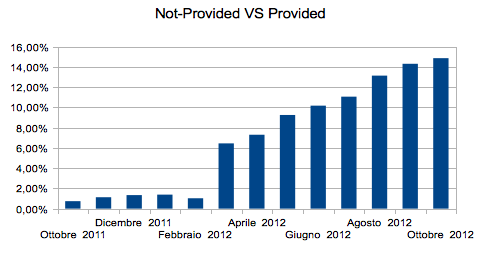
Not Provided vs Provided evolution 2010-2012
Social traffic
The impact of social media in organic traffic is, without a doubt, one of the most important events of the last few years.
This trend is evident in Italy, too. Keep in mind that in Italy, the "mainstream acceptance" of new Internet tools usually happens later than in the USA (or UK). This was the case for Twitter, which just exploded during the last 14 months. That said, this delay in accepting and using new tools seems increasingly shorter, as exemplified by the acceptance of Pinterest, which in Italy has suddenly adopted in close comparison to the rest of the world.
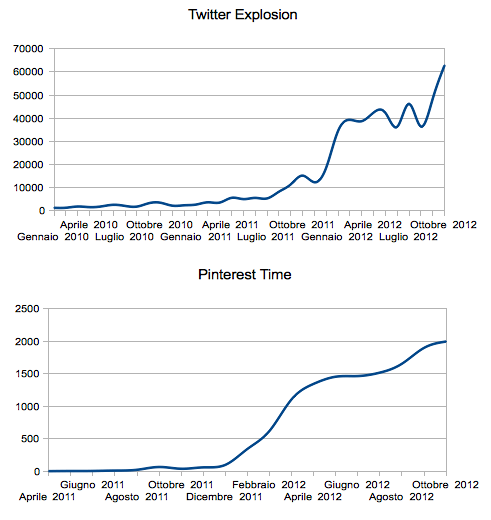
Twitter and Pinterest explosions in Italy
In Italy, social media's status of "popular" and only used by a small, very active group of early adopters changed to become widely accepted between 2010 and 2011. Social media is now part of a completely mainstream environment (+1768%). But the data collected via ShinyStat shows us that around October 2011, the referral traffic from social media had a dramatic boost. This boost was so powerful that in October 2012, the traffic from social media was equal to the one between January and October 2010!
If we compare this chart with the chart highlighting the evolution of visits from search engines presented in the beginning of this post, we will see that news and events are the main generators of traffic from social networks. It is a completely natural occurence as social media outlets are the places where people discover news, talk about what's going on in their area, and even generate news stories.
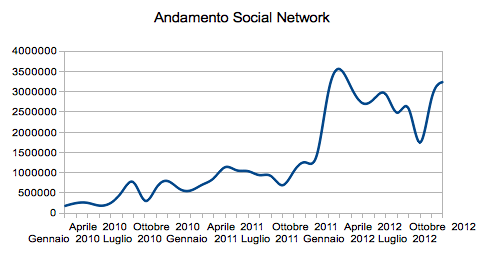
Evolution of traffic from social media in Italy between 2010 and 2012
Twitter and Pinterest are interesting and important social networks, but in social media (as in search), there is just one, almost monopolistic, dominator of social media in Italy: Facebook.
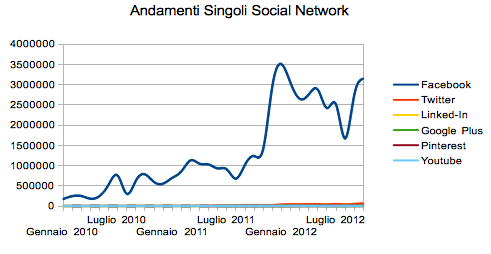
Evolution of traffic from the different social networks in Italy between 2010 and 2012
Right now, Facebook represents 97.69% of the referral traffic from social networks, while the amount of visits generated by the other social networks is almost “symbolic:”
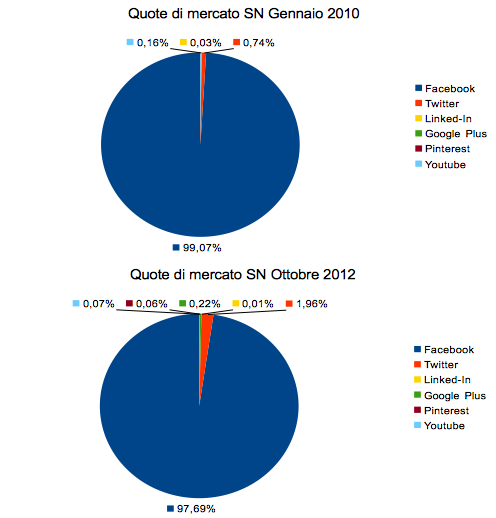
Social network market shares in Italy 2010 vs 2012
As we can see, just 0.22% of visits from social networks right now are from Google+. However, recent studies show that in the last couple of months, Google+ is actually growing with a faster rhythm than Twitter.
So, how is it the overall quality of traffic from social networks in Italy? Not so good, according to metrics like bounce rate and pages per visit that Paolo used in order to have a first raw “quality analysis.” Bounce rate from social is usually very high, and the time per visit and pages per visit numbers are much lower than the numbers from search engines.
With these statistics, is it possible to represent the larger influence of social versus the use of search in Italy? Yes, it is:
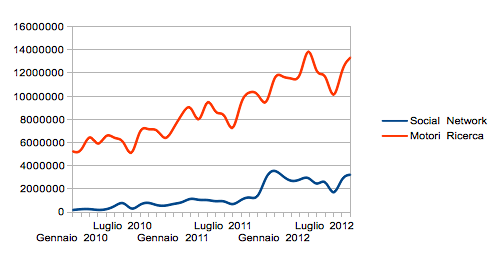
Search traffic vs social traffic in Italy between 2010 and 2012
Both are growing, but the distance between search traffic and social traffic is getting smaller.
If we visualize the traffic volumes in percentages, then the growing importance of social networks is even more evident. Here are the social traffic shares in January 2010:
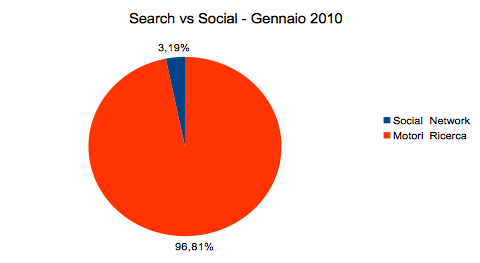
Search vs. social in Italy on January 2010
And here in October 2012:
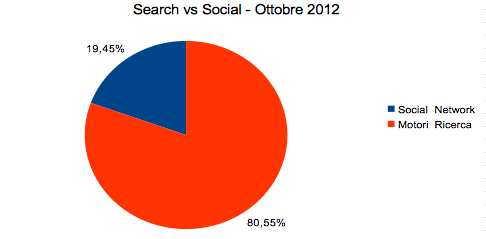
Search vs. social in Italy on October 2012
All of these “versus” analyses are confirming something we already know to be true through experience: in Italy, the real competitor of Google is Facebook:
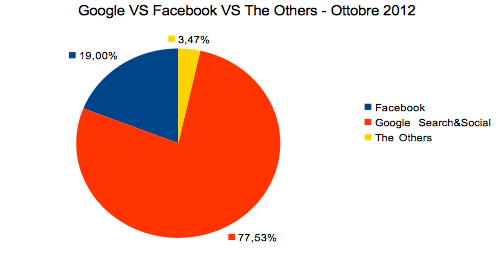
Google vs. Facebook vs. Others (i.e. search engines and social networks) on October 2012
Desktop vs. mobile
Mobile is an hot topic, and the charts we see usually refer to USA or UK markets. But what about countries like Italy? Maybe you don’t know yet, but Italy (and, similarly, Spain), is one of the nations where the mobile market is more evolved than the biggest players in the technology game.
The ShinyStat data shows us how mobile is on the rise in Italy. Thanks to the über fast evolution of smartphones, the introduction of iPad and Android phones/tablets, and the use of Internet everywhere, mobile is literally exploding:
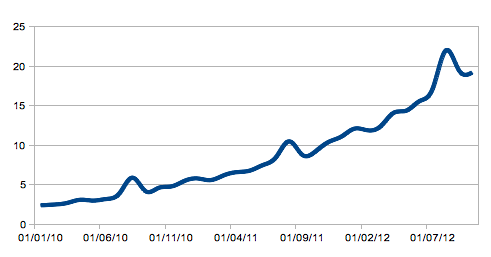
Growth of visits from mobile in Italy between 2010 and 2012
In less than three years, the traffic from mobile devices to Italian sites grew 8x. The spikes are easy to understand as they correspond to August’s metrics. Italians cannot seem to shut their smartphones off (even when they are on holiday), and during August 2012, one of five visits came from a mobile device.
In reference to mobile iOS, Italy reflects global trends well:
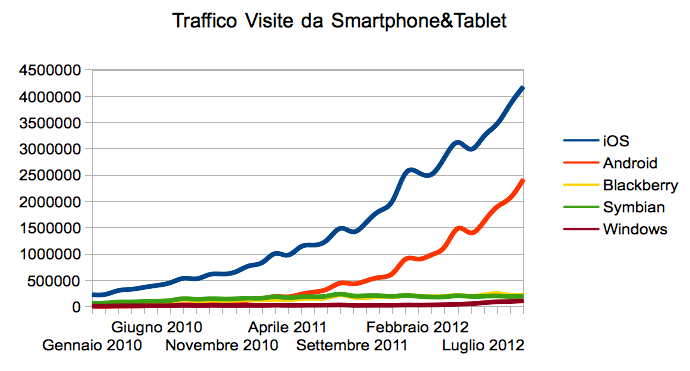
Evolution of traffic from mobile and iOS in Italy between 2010 and 2012
In Italy, too, we see that there are two clear competitors: iOS (Apple) and Android (Google).
It is interesting to notice that the distance in terms of traffic generated between the two operating systems seems stable. What does that mean? It means that Android didn't really eroded market share from Apple, but inherited users from all the platforms outside of iOS, especially Symbian:

Mobile market shares by iOS in Italy on January 2010
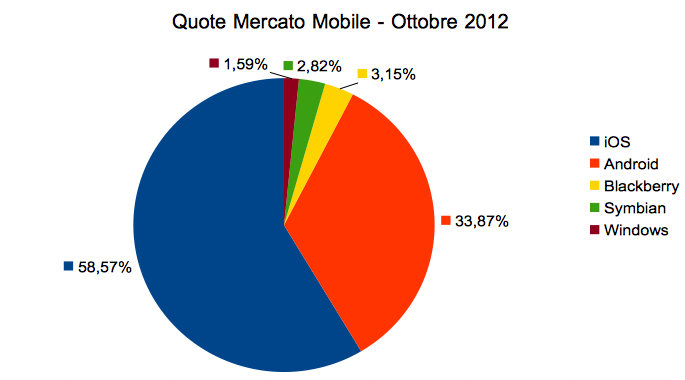
Mobile market shares by iOS in Italy on October 2012
The ShinyStat data allow us to dig even deeper into the analysis of mobile traffic. For instance, let's take a look at the traffic from Apple devices. In this chart, we can see that users are moving from using their iPhones for searching and visiting sites to using iPads:
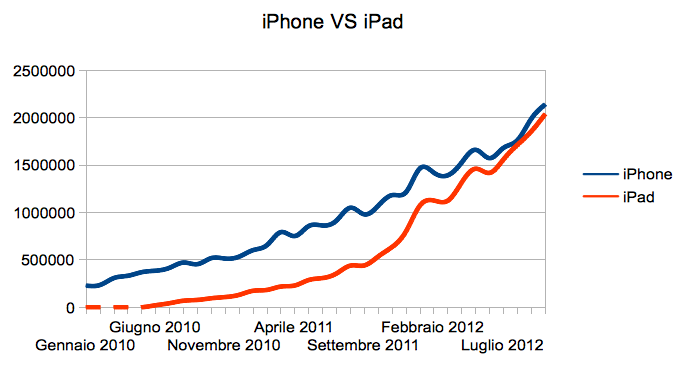
Traffic from iPhone vs traffic from iPad in Italy between 2010 and 2012
The war of the browsers
Part of the analysis presented by Paolo Zanzottera was focused on which browsers are used for visiting Italian sites between 2010 and 2012:
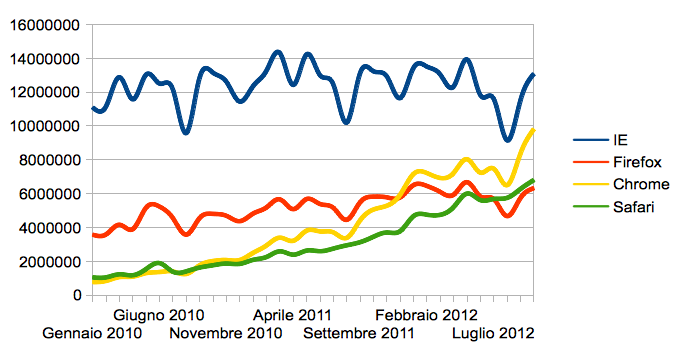
Browser use between January 2010 and October 2012
We can easily see how Internet Explorer (and, similarly, Firefox) were used for steady amounts of visits to Italian sites between 2010 and 2012. In an agrressively competitive industry that is ever-changing, this statistic is basically saying that Internet Explorer and Firefox lost market share for being static. The charts below give us even more confirmation:
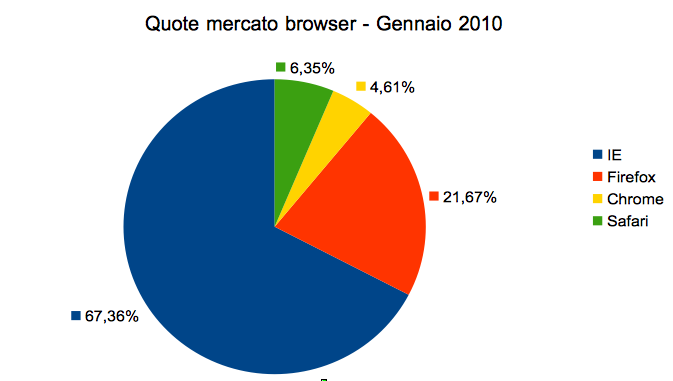
Browser market share January 2010
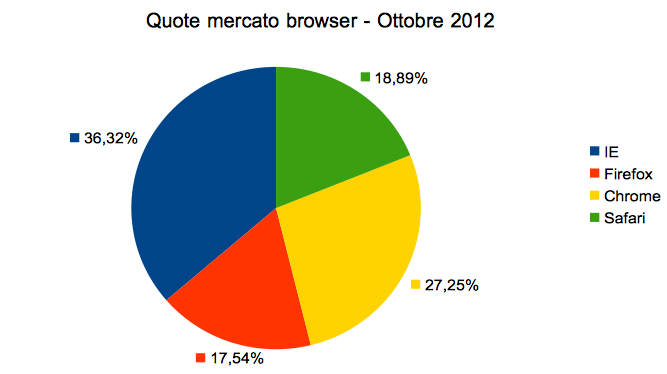
Browser market share October 2012
Takeaways
So, what conclusions about the Italian Internet and search industry can we draw from this analysis?
First, thinking about optimizing for Google only while working as an inbound marketing strategy is shortsighted, even in countries such as Italy (and most likely the other European countries) where Google has no stand-out competitor in search. User behavior suggests that, although Google is currently winning the race, they might not be forever. Along with that thought, the weight of social media (with Facebook leading the charge) is so heavily tied to SEO that today, it could be synonymous with the term "SEOcial."
Secondly, it has become absolutely clear that even in a market like Italy's (and certainly Europe as a whole), we must understand that the Internet is everywhere, and we must complete the final transition from a desktop-only world to a multi-device Internet marketing strategy. As a consequence, conversion rate optimization of mobile sites, not just SEO, should be a priority of every web marketer during 2013.
Finally, a more general conclusion can be made: user behavior when searching and using the Internet is changing at a rate even higher than that of just a few years ago.
If we use the Italian case as a benchmark, we have observed that the market is largely different today from what was just two years ago. The increased speed in changing behaviors is a factor that needs to be explained, especially to those whose decisions make the most impact in any business. A lengthy amount of time spent on decision making, fueled by excessive bureaucracy, can be equal to a disaster online at the current rate of change.




Comments
Please keep your comments TAGFEE by following the community etiquette
Comments are closed. Got a burning question? Head to our Q&A section to start a new conversation.